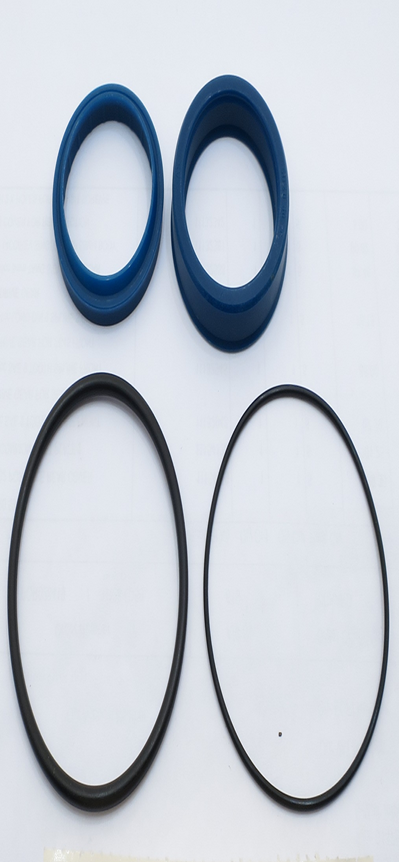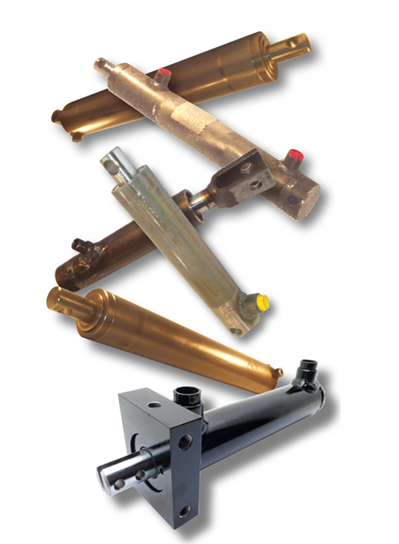Guide for Replacing Seals on Hydraulic Cylinders
Hydraulic cylinder leaks can develop from normal wear and tear and lead to hydraulic cylinder / ram failure if not repaired. One of the most common causes of hydraulic fluid leaks comes from worn or damaged seals.

Fortunately, repairing and replacing seals on hydraulic cylinders is not a difficult maintenance procedure as long as you completely understand hydraulic systems and follow these simple repair process steps.
Step 1: Order a new set of seals for your hydraulic cylinder.
To repair the cylinder, you will need a new set of seals. You will need to determine what type of hydraulic cylinder you have—either wire ring or threaded gland—and order the appropriate replacement seal kit. If you are unable to identify the kit required from manufacturer information or cylinder part number, proceed straight to Step 2.
Step 2: Prepare your hydraulic cylinder for repair.
Before removing the hydraulic cylinder from the equipment, you need to clean it and remove all dirt, grease, oil, and debris. You do not want these contaminants to get inside the cylinder or the hydraulic system.
Step 3: Remove the hydraulic cylinder for maintenance.
You will need to remove the hydraulic cylinder from the equipment to repair it and or identify the seals required. Make sure to cap off any inlet and outlet hydraulic fluid pipes to prevent dirt, dust, and moisture from getting into the hydraulic system.
Step 4: Perform repairs in a clean location.
You need to do the repair in an area free from moisture, dust, and dirt. If you are in the field, you can put down a clean tarpaulin and do the repair on this. For indoor locations, ensure the surface the cylinder is placed on is clean.
Step 5: Disassemble the cylinder.
The type of hydraulic cylinder will determine how you take it apart. For example, you will need to remove the external and internal steel wire rings on a wire ring cylinder to take it apart. For a threaded gland cylinder, you just need to unscrew the end cap.
Regardless of the type of cylinder, you will want to pay attention to the rod seals, piston seals, rod assembly, and related parts as you carefully remove them. You will also want a wrench, punch pliers, rubber mallet, and other essential tools to disassemble the cylinder and remove the piston and the rod.
Step 6: Check for any internal damages.
After removing the cylinder rod:
- Check for any scratches, pitting, or other damages.
- Take a look at the rod seals to see if they are worn unevenly; this could indicate the piston rod is bent or there is excessive side loading on the rod.
- Use your fingers to feel the interior of the tube to verify it is smooth and free of scoring and corrosion.
If you discover any internal damages, you will want to replace the affected parts or order a new cylinder if multiple components are damaged.
Step 7: Remove and replace the seals.

Remove the seals from the cylinder one at a time. After they are removed, use an emery cloth to clean the area where the seals were installed. You need to be certain that the seals and any buildup of debris or lacquer around them is completely removed.
Next, using your fingers, lubricate the seals and install them in the correct positions. Lubricate the interior of the cylinder tube with hydraulic fluid and reinstall the piston, rod, and other cylinder components.
Step 8: Reinstall the cylinder.
After verifying the cylinder was reassembled correctly, reinstall it on your equipment and reattach the hydraulic pipes.
Step 9: Test the cylinder.
You will want to test the cylinder to verify the leak has been fixed by turning on the equipment and engaging the cylinder. If you notice any leaks, something was not repaired correctly. So, you will need to remove the cylinder and verify the seals are in the proper locations. Also recheck for any distortions or excessive wear on the inside of the gland that may mean that this needs to be replaced too.
Final Thoughts on Seal Replacement
Replacing seals on a hydraulic cylinder is not difficult when you know what you are doing. However, leaky seals could be a sign of a bigger problem. So, you will want to troubleshoot what went wrong and determine if there are issues with the hydraulic system that also need to be addressed.
At White House Products, Ltd., we stock replacement
hydraulic cylinders,
seal kits,
pumps,
motors, and a wide range of hydraulic parts and accessories. Explore our inventories online or contact us at +44 (0) 1475 742500 to order your parts today!
Back to blog posts